Table of contents
- Background on the window lock in the Dolomites Repealed or postponed?
- Quickly prove activism?
- “Without motorcyclists, everything here is deserted”
- 1830 vehicles per day, including 384 motorcycles
- interview
- Stilfser Joch – soon to be a UNESCO World Heritage Site?
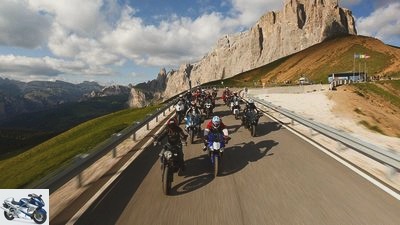
jkuenstle.de
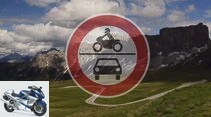


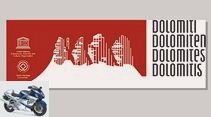
7th pictures
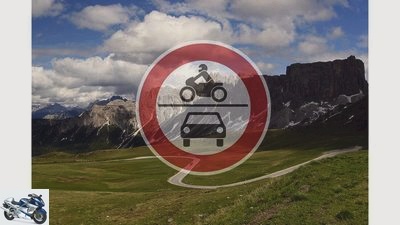
www.j.kuenstle.de
1/7
Photo gallery: Window lock in the Dolomites.
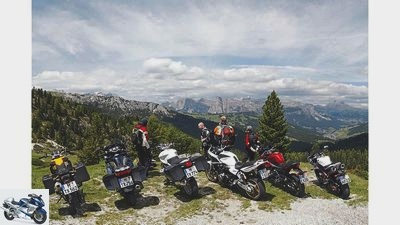
jkuenstle.de
2/7
Fixed on the road, hardly interested in the Dolomites World Heritage Site: only a few bikers enjoy nature.
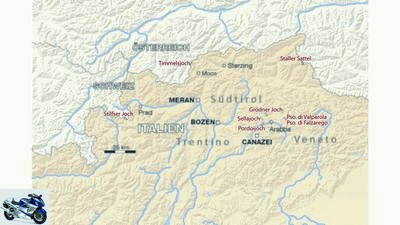
3/7
In sight: the Sella circuit, including the Passes Gardena, Sella and Pordoi. But there are also new plans on the Stilfser Joch (left) …
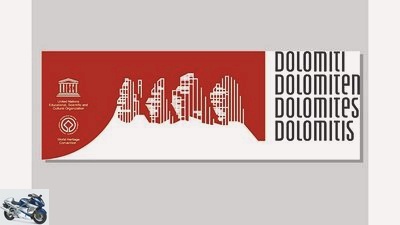
UNESCO
4/7
World Natural Heritage Dolomites: Allegedly, closures are necessary because of this UNESCO title.
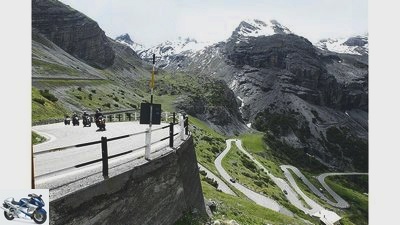
Rossen Gargolov
5/7
… Stilfser Joch – soon also a UNESCO World Heritage Site? The 48 hairpin bends of the north-east ramp make the Stilfser Joch one of the last motorcycle adventures in Central Europe. …
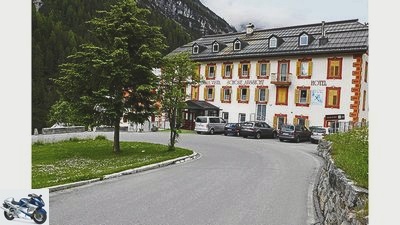
www.factstudio.de
6/7
… Curve 46 in Trafoi is currently being redesigned.
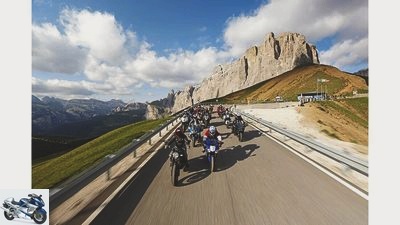
jkuenstle.de
7/7
In view of the disagreement between politicians, associations and the population in the Dolomite regions of South Tyrol, Trentino and Veneto, the Sella circuit remains open – at least for the time being.
counselor
traffic & business
Report window lock in the Dolomites
Background on the window lock in the Dolomites
Repealed or postponed?
The announced window lock on the Sella Joch was called off – at least for 2016. However, politicians and institutions are urgently pushing for traffic restrictions in the Dolomites. So the lock is only postponed, not lifted?
Eva Breutel
05/25/2016
It sounded frighteningly concrete: From this summer onwards, so-called window closings should come on the Sella Joch, in the heart of the Dolomites, and motorized traffic should be completely stopped for three hours every day at lunchtime in July and August. In addition, it was planned to extend the closure to the entire Sella circuit in the following years, including the Gardena Pass, Campolongo and Pordoi Pass. A type of traffic calming that politicians in South Tyrol and Trentino had in mind for a long time, but which was only possible at the beginning of 2016 because the Italian Council of Ministers approved a corresponding provision in February: According to this, South Tyrol and Trentino are now allowed to “take measures to protect traffic on their own of the environment and landscape ”.
Buy complete article

Background on the window lock in the Dolomites
Repealed or postponed?
6 pages) as PDF
€ 2.00
Buy now
But the neighboring communities of the Sella-Runde, from Canazei to Corvara, and especially the hotel and restaurant operators, ran storm against the plan; they fear enormous losses in tourism, which has been the main source of income in the Dolomites for decades. And so the politicians from South Tyrol and the Trentino backed off again for the time being. “This year there will be no closures on the Dolomite passes”, says Florian Zerzer, Director of the Spatial Development, Environment and Energy Department of the South Tyrol State Government and coordinator of the “Dolomite Passes” working group, in an interview with MOTORRAD. “But we are still looking for ways to reduce motorized traffic.” In general, the aim is to attract more tourists to the Dolomites, but at the same time reduce motorcycle and car traffic.
Quickly prove activism?
The title “World Natural Heritage”, which the Dolomites have had since 2009, is often used as a reason for the increased demand for eco-tourism. UNESCO, it is said, is demanding a functioning mobility concept, otherwise the title may be withdrawn. But in response to a request from a member of parliament, the South Tyrolean provincial government replied last October that “there is no indication of this possible risk”. And continues to write: “As far as the passes in South Tyrol are concerned, we would like to point out that none of them are in the World Heritage area.” So why should the Sella be closed? Insiders suspect that politicians and associations wanted to divert attention from their own failures. Because there were many traffic concepts for the Dolomites, from a fast train connection to pollution-free buses to the large cycle path; However, next to nothing was implemented.
In autumn 2016, an inspection by UNESCO is actually due, which also deals with tourism management. So it makes sense to quickly show actionism by closing the route. By contrast, the politicians have moved away from a toll for the time being; The Timmelsjoch serves as a deterrent example, where traffic has increased despite the hefty prices (one-way trip by motorcycle: 14 euros). And you don’t want that at all in the Dolomites.
After the window was blocked for the time being, there are already new projects. Numerous “green events” are planned, for example cycling days with attached e-bike rental for the less sporty, or folk festivals on the pass heights; the respective pass road would be closed to motorcycle and car traffic on these occasions. Ideally, according to a strategy paper, such events should take place every two weeks. Obviously, it is hoped that this will gradually wear down the stubborn locals who are resisting the lockdowns.
“Without motorcyclists, everything here is deserted”
It does not look like that, however, as Osvaldo Finazzer emphatically assures. Ten years ago, the man from Trentino, who runs two hotels high up on the Pordoi Pass, founded a committee of businesspeople on the passes, which vehemently speaks out against possible closures. There are now 79 companies with more than 600 employees from the provinces of Bozen, Trento and Belluno, all of which border the Sella-Runde. “What the politicians say doesn’t count,” snorted Finazzer. “After all, we live and work here, not them.” Of course, tourists on foot, bike or electric vehicle are very welcome along the entire Sella circuit, but these should not be played off against motorcyclists and motorists: “Without them, everything would be deserted.”
The mood among the various tourist groups in the Dolomites is already irritating. Motorcyclists in particular are in the crossfire of criticism, and mountaineers and hikers complain bitterly about them in internet blogs. On the one hand, it is about high speed, but above all about the noise level. A topic that a recently presented study by the private institute Eurac in Bolzano (see interview below) on traffic on the Dolomite passes deals with. Although the researchers did not find any excessive noise levels from the motorcycles at their measuring points, they cited hikers who were seriously annoyed by the motorcycle sound. Barrier opponent Osvaldo Finazzer, himself a committed driver of a Harley Ultra Limited, admits that motorcyclists with emptied mufflers repeatedly cause a lot of displeasure. These are only a few, but they bring the whole group into disrepute. “I can only appeal to drive with a proper exhaust. Especially since there are now more noise controls by the police on the Sella circuit. “
1830 vehicles per day, including 384 motorcycles
The question that remains is how many vehicles are actually involved. The aforementioned study on traffic on the Dolomite passes comes to the conclusion that around 1.2 million vehicles cross the Sella Joch every year. That sounds like a lot at first, but even in summer that’s no more than 1,830 vehicles a day on average, 384 of which are motorcycles. The exhaust emissions determined in the study are far below those in the valley, as are the noise emissions. Hotelier Finazzer can’t really explain the excitement about the pass roads anyway: “The traffic has decreased in the last few years, I see it day after day, even without a study. Holidays in the mountains are not cheap, and the Italians in particular have less money to spend than before due to the economic crisis. ”According to his observations, there are traffic jams and crowds in the parking lots“ only on a very few days a year ”. Namely in midsummer, and then only when the weather is good.
But the regional politicians from South Tyrol and Trentino are not giving up anytime soon. In order to scientifically underpin their planned catalog of measures – fewer parking spaces along the pass roads, more speed restrictions, window closings and significantly more “green events” – there will be another survey on the Dolomite passes between June and September 2016. “We want to know where the traffic is coming from and where it is flowing to, so that we can then channel it if necessary,” says Florian Zerzer from the South Tyrolean provincial government, who coordinates the “Dolomite Passes” working group. However, according to Zerzer, the measures are not directed against motorcyclists in particular: “Of course you are still welcome, after all, the Dolomites are a tourist area.” However, in the future, perhaps not every pass could be open to motorcyclists every day.
Osvaldo Finazzer sees it differently. “Especially the motorcyclists, who come in the off-season from May to mid-July and in September and October, we need here every day, without them many hotels could close immediately.” He adds militantly: “The Sella circuit is this year open, and it will remain open, we’ll take care of that. ”In view of the disagreement between politicians, associations and the population in the Dolomite regions of South Tyrol, Trentino and Veneto, he could be right – at least for the time being.
interview
Anna Scuttari (30) works for the private research institute Eurac in Bolzano. On behalf of the UNESCO Dolomites Foundation, the tourism and economics scientist worked with several colleagues on a study * on the traffic situation on the Dolomite passes, especially the Sella circuit.
What exactly did you and your colleagues investigate in the “Dolomite Passes” study??
Among other things, the traffic volume by means of a traffic count. We also analyzed the exhaust and noise emissions, conducted individual surveys of tourists on the Sella Joch, interviewed mayors and representatives of the tourism associations and analyzed the practices on other alpine passes such as Timmelsjoch or Grobglockner.
And your results?
Basically, the traffic problem on the passes arises especially in summer, especially on weekends with nice weather, which was to be expected. According to our calculations, around 1.2 million vehicles pass through the Sella Joch each year, 70 percent of them in summer. In terms of noise emissions, we found that the volume depends less on the mode of transport and more on the speed and driving style. As a rule, it is the motorcyclists who travel faster.
Did you also ask about the response to possible blocks or tolls??
Yes. If there was a toll, most of the tourists surveyed would forego visiting the Sella Pass; however, half of the motorcyclists were willing to pay. If the Sella is closed for two or three hours a day, most tourists want to go up before or after. Locking windows like this would at best have a symbolic character, they would not reduce traffic, and there would even be more traffic jams. A broader lockdown could work according to our results, but only if there are alternative transport connections, such as buses. But that is not the case at the moment, and that is where the main problem lies. The Dolomites belong to three different regions with over 130 municipalities, which all have to coordinate.
Now what is your conclusion?
That there are no simple solutions for the Dolomites if you want to reduce individual traffic. Every pass is different and needs its own measures, this can only be clarified by further investigations. In general, ecologically compatible events could help to sensitize locals and tourists.
According to the measurements of the study, motorcycles, which anyway only make up ten percent of the traffic on the Sella Loop, are no louder than cars. Why are they still blamed for the noise??
There are some noticeable individual cases, a single loud motorcycle can be heard all over the pass road, which bothers everyone else. In addition, with the same number of decibels, the noise of a motorcycle is perceived as more penetrating than that of a car. And finally, it comes down to the measurement points: If we had measured elsewhere, the results might have been worse for motorcycles.
You drive a Ducati Monster yourself. What do you advise motorcyclists in the Dolomites?
Many politicians and associations criticize the fact that motorcyclists are not interested in the Dolomites, but only in the road, so drive up the pass, stop for a moment, and go on. It would be helpful to pay more attention to nature, although it is of course difficult to go on a hike with a helmet, boots and station wagon, as I know it myself. One solution might be structures on the passes where motorcyclists can safely store their equipment. So far there has not been anything like this.
Stilfser Joch – soon to be a UNESCO World Heritage Site?
Expansion to a panoramic road, new route at the top of the pass, tunneling – there are many projects on the Stilfser Joch.
The Stilfser Joch, located around 200 kilometers west of the Dolomites and at 2,757 meters one of the highest pass roads in Europe, would like to be upgraded by UNESCO: According to the South Tyrolean provincial government, the impressive pass road should soon become a “technical world cultural heritage”. It undoubtedly deserves that with its numerous bends – 48 on the South Tyrolean side, 34 in Lombardy – and the breathtaking route. The only question is what that means for private transport and thus also for motorcyclists. In 2012, South Tyrol absolutely wanted to introduce a toll for the Stilfser Joch, but then the Italian region Lombardy and Switzerland, both of which also border the pass, did not play along, and the plans came to nothing. The South Tyrolean governor Arno Kompatscher recently brought a toll back into play, and the mayor of Stelvio also described it as “huge business”, but so far the words have not been followed by any deeds.
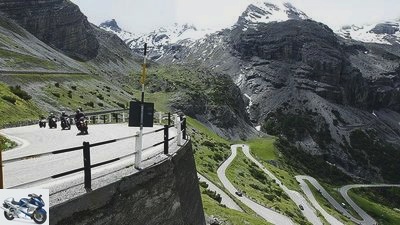
Rossen Gargolov
The 48 hairpin bends of the north-east ramp make the Stilfser Joch one of the last motorcycle adventures in Central Europe.
An alternative plan from South Tyrol and Lombardy now envisages upgrading the Stilfser Joch and expanding it into a panoramic road. Among other things, they want to create several viewpoints and parking spaces and defuse some hairpin bends. On the South Tyrolean side, hairpin bend 46 in Trafoi is currently being redesigned, the curve radius is being increased from 8.8 to 14 meters in order to “ensure more safety”. We are also talking about completely changing the layout of the road over the last few meters; the top of the pass would then only be accessible on foot. Admittedly, things are very tight there at the moment, due to the lack of parking spaces, motorbikes and cars jostle in wild colors on the side of the road on summer days.
After all, the motorcyclists were not forgotten in the renovation plans: “So that they can get up on foot relatively carefree, there should be lockers for helmets and jackets,” says Hugo Ortler, owner of the “Tannenheim” hotel in Trafoi am Joch and host of the Alpine Masters, MOTORRAD’s big alpine test. But it is not that far yet; first of all, a study on the conversion is to be carried out. As if that weren’t enough, a further study on the initiative of Lombardy will clarify whether a train or car tunnel under the Stilfser Joch is worthwhile. In all likelihood, however, the project is likely to fail due to the enormous costs of around 40 kilometers of tunnel construction across the Ortler massif.
And what is the current situation for motorcyclists on the Joch? “Everyone who lives and works on the Stelvio Pass is very welcome,” says hotelier Hugo Ortler. He believes that it is wrong to rely exclusively on eco-tourism, primarily with cyclists, as some politicians are promoting. “We can’t live on that, most of the tourists would stay away,” he says laconically. “Once nothing is going on, it will be gentle all by itself. Too gentle. “
Related articles
-
Report: This is how Austria’s police make money
archive to travel Report: This is how Austria’s police make money Report: rip off or just punishment? This is how Austria’s police make money Right line…
-
Yamaha Tracer 700 in the HP driving report
Yamaha 28 pictures Yamaha 1/28 Yamaha Tracer 700 in the HP driving report. Yamaha 2/28 Yamaha Tracer 700 in the HP driving report. Yamaha 3/28 Yamaha…
-
Report: House search too fast because of 48 km / h
jkuenstle.de counselor traffic & business Report: House search too fast because of 48 km / h House search too fast because of 48 km / h Open up, police!…
-
Aprilia motorcycles Aprilia report Aprilia report Is the reputation only ruined… …Live it is not at all unabashed. That is why Aprilia is trying to…
-
Driving report Kawasaki ZRX 1200 S and ZR-7 S
motorcycles Driving report Kawasaki ZRX 1200 S and ZR-7 S Driving report Kawasaki ZRX 1200 S and ZR-7 S Partly cheerful With the ZRX 1200 S, Kawasaki is…
-
Motorbike trip in the Alps – alternative to the Dolomites
shepherd 29 pictures shepherd 1/29 Motorcycle trip: Alpine tour against the untravelled. shepherd 2/29 Motorcycle tour: Alpine tour against the…
-
Markus Jahn 14th pictures Markus Jahn 1/14 The panoramas in the Dolomites are impressive. Markus Jahn 2/14 But the curves are also challenging. Markus…
-
Drawing: Werel counselor traffic & business Report: route closures Report: Line closures in Hessen Motorcycling prohibited! Eight years after the tragic…
-
motorcycles Driving report Ruko V 1000 SC Driving report Ruko V 1000 SC Total work of art The idea, construction, design and the craftsmanship of the…
-
MV Agusta Stradale 800 in the driving report
MV Agusta 22nd pictures MV Agusta 1/22 MV Agusta Stradale 800. MV Agusta 2/22 MV Agusta Stradale 800. MV Agusta 3/22 MV Agusta Stradale 800. MV Agusta…